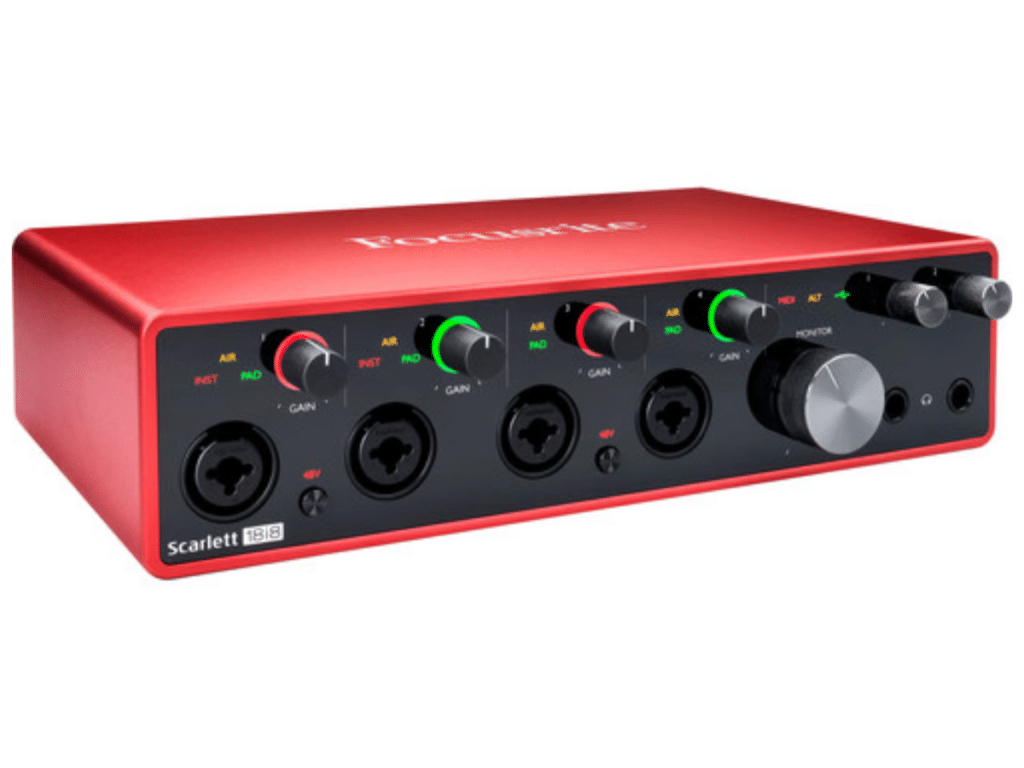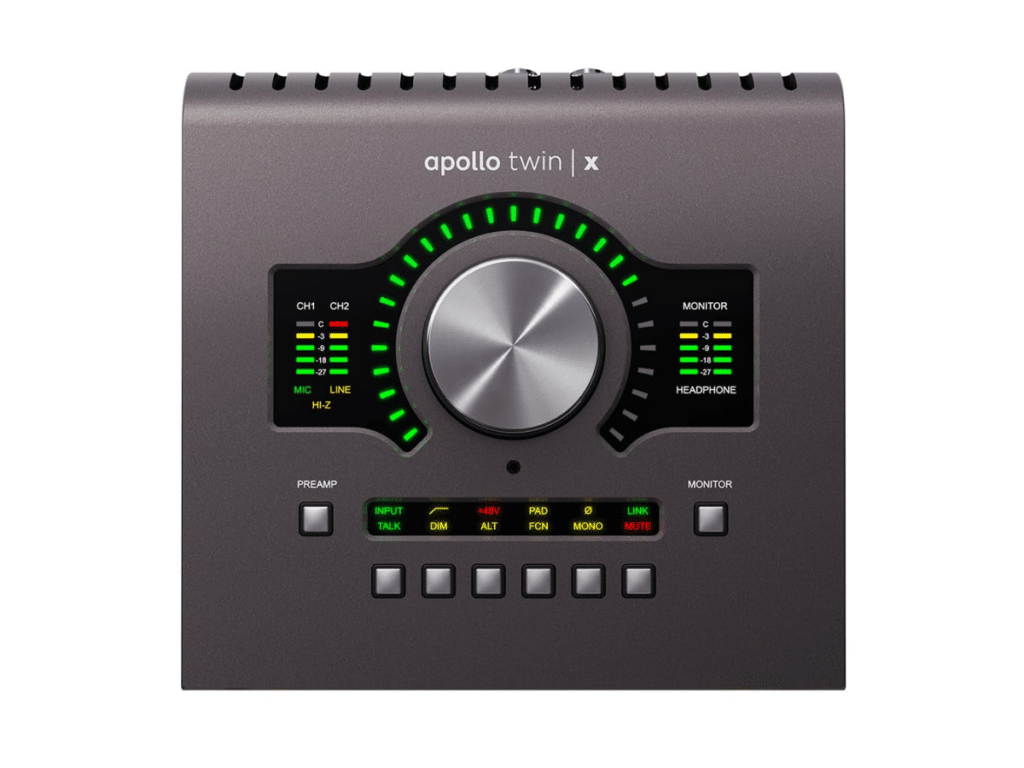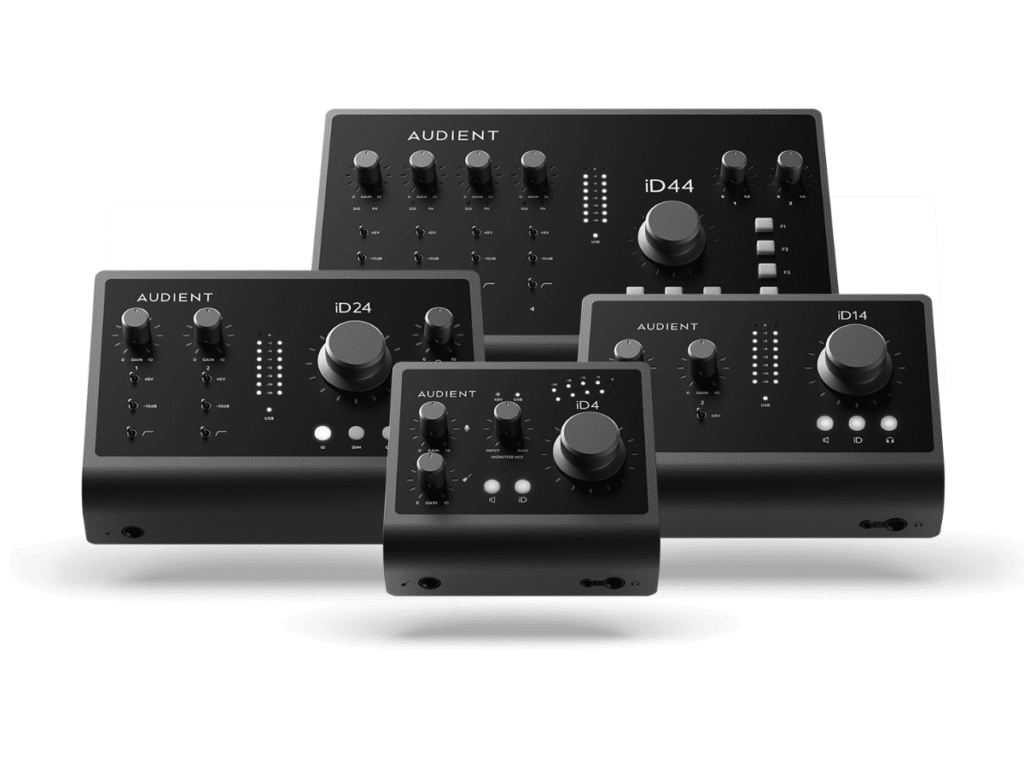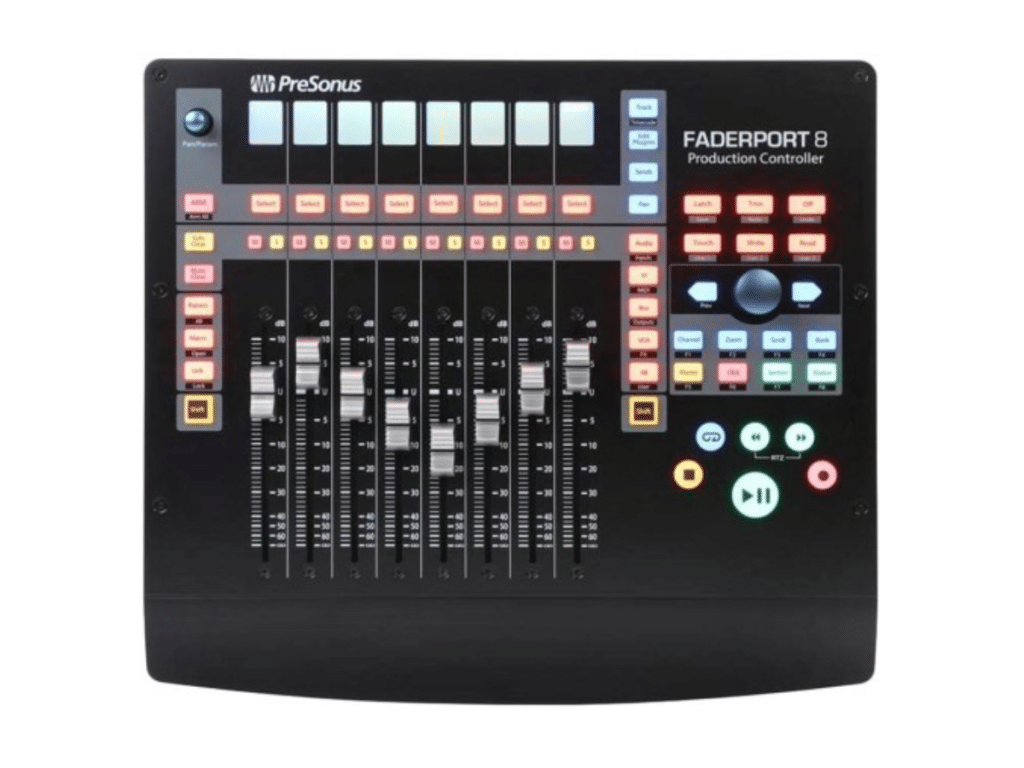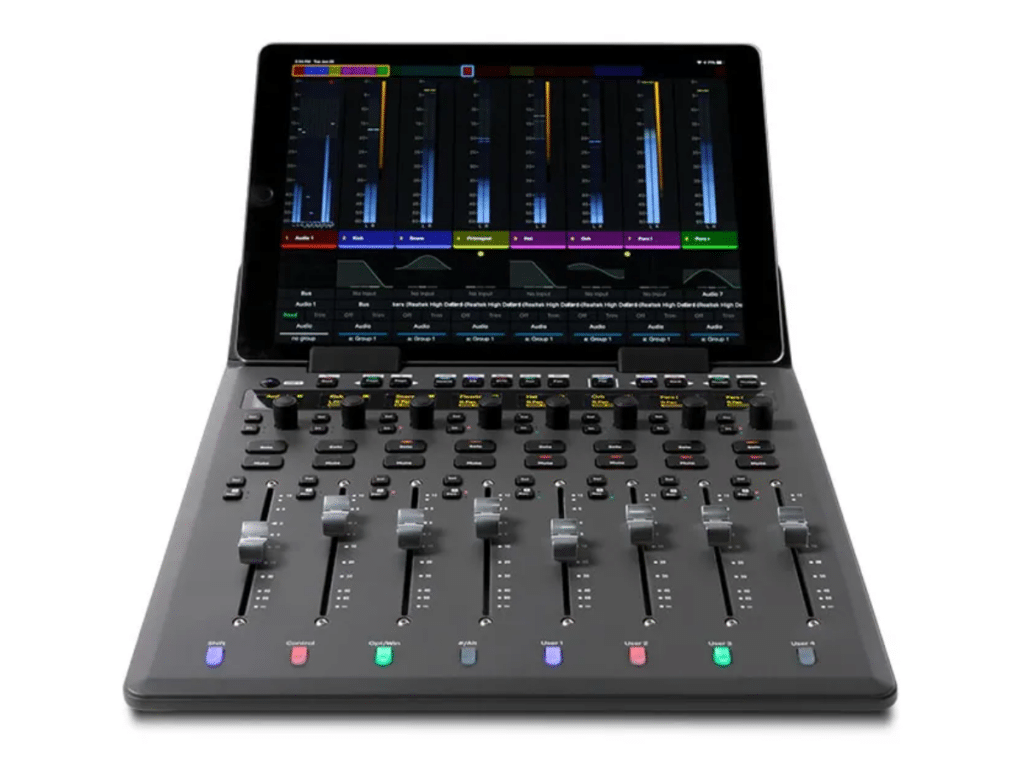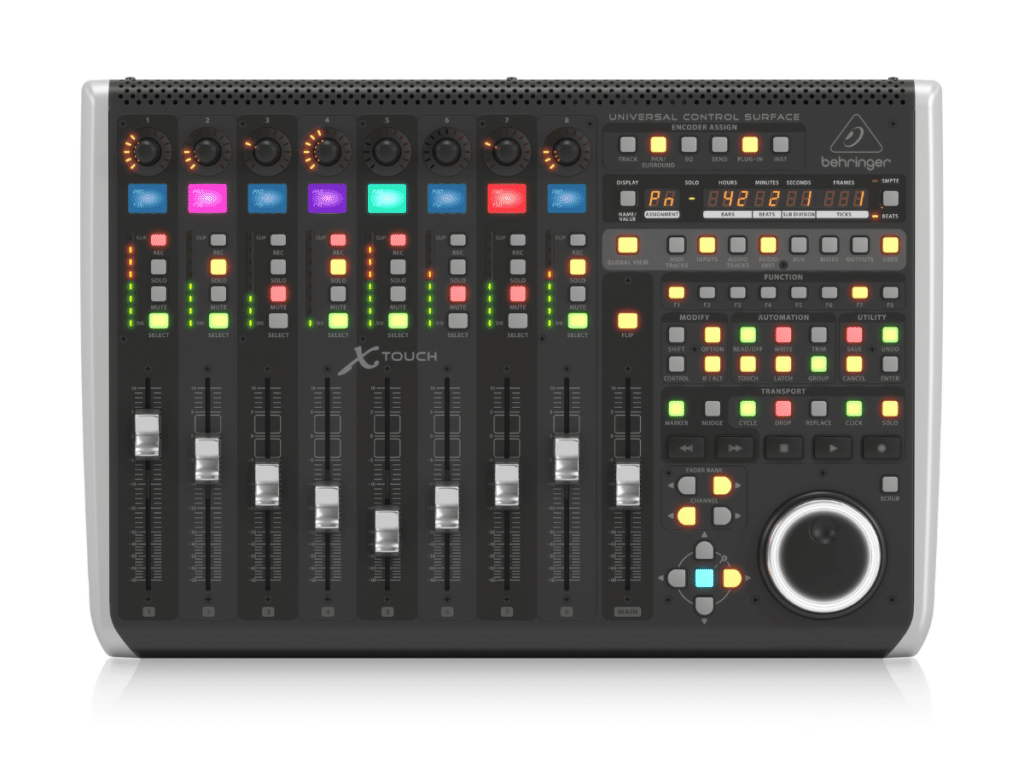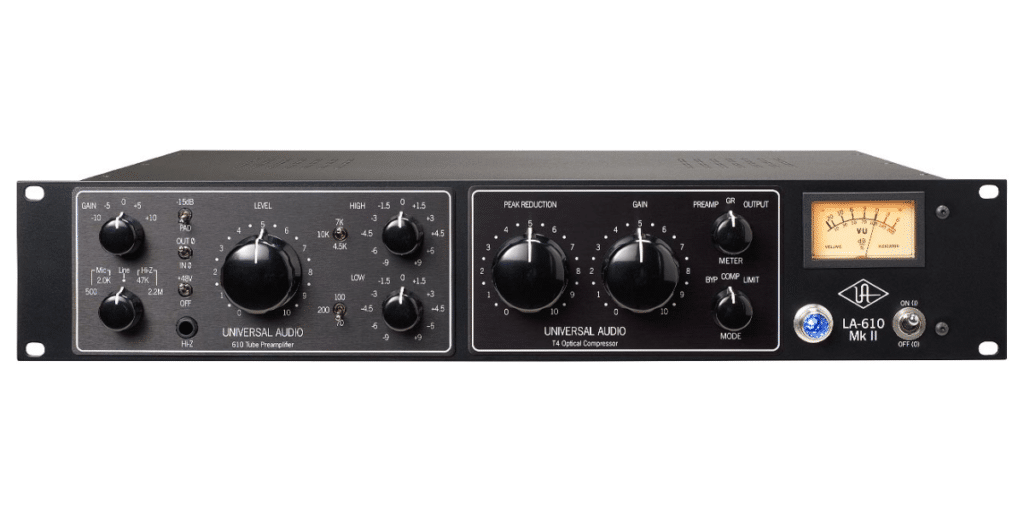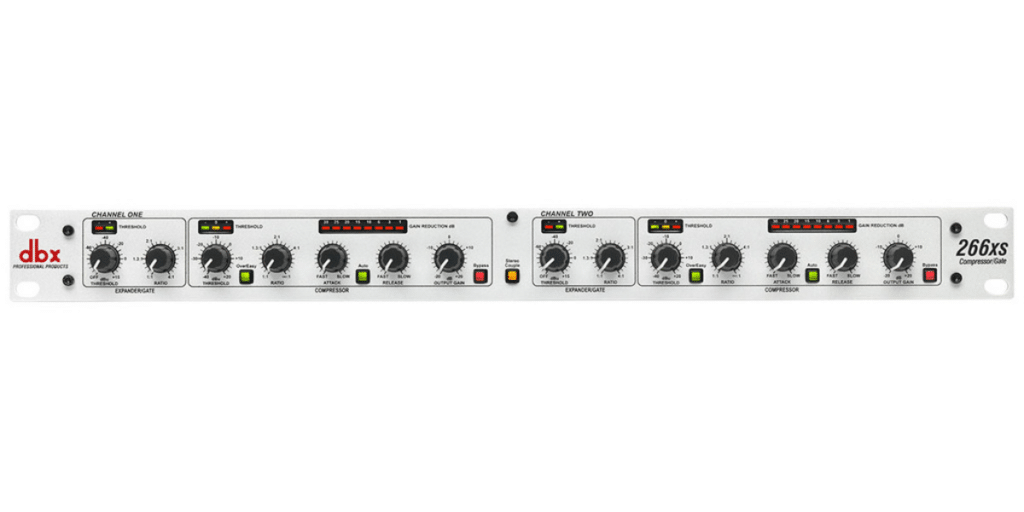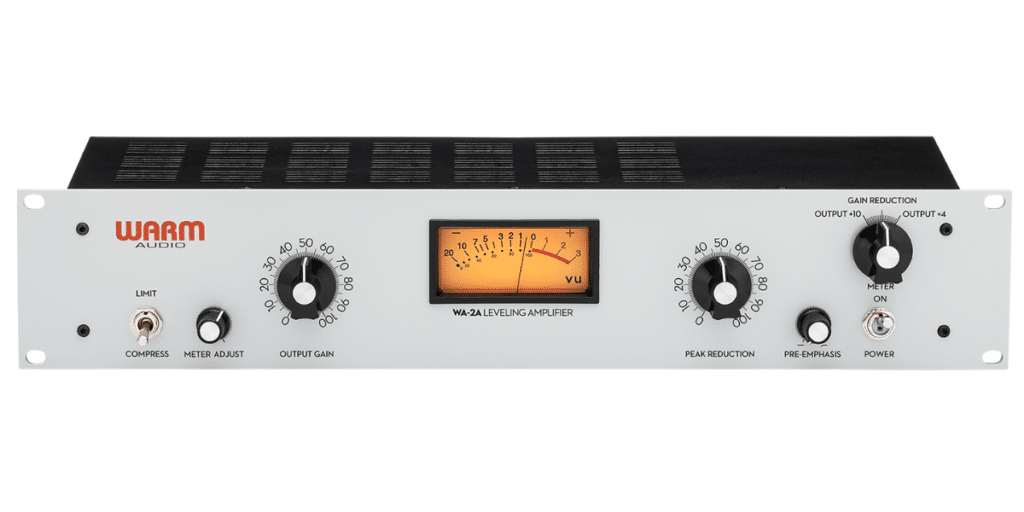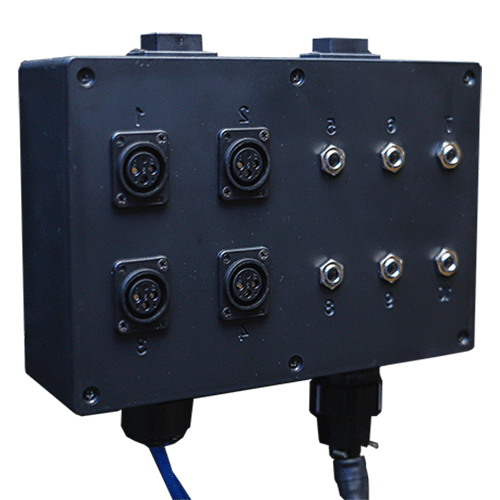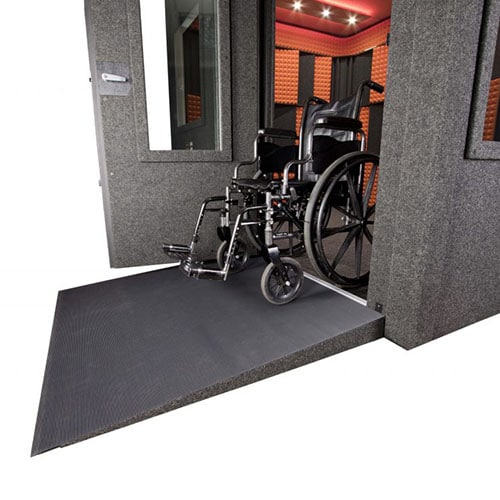Recording your voice can be an exciting and rewarding experience, whether you’re a seasoned voice actor, a passionate singer, or a captivating narrator. The ability to immortalize your voice in a recording is a remarkable opportunity to convey emotions, tell stories, and connect with your audience. However, amidst the thrill, it’s crucial to navigate the potential pitfalls that could hamper the brilliance of your recordings.
In this article, we delve deep into the art of recording and unveil the common mistakes to avoid. Brace yourself for invaluable insights and expert tips that will empower you to elevate the quality of your recordings, ensuring they resonate with clarity, professionalism, and captivating authenticity. Get ready to unlock the secrets to achieving a pristine audio masterpiece that will leave your listeners spellbound.
1. Neglecting Proper Equipment and Setup
One of the most crucial aspects of recording your voice is having the right equipment and a well-optimized setup. It’s no secret that the quality of your recordings heavily depends on the tools you use. While it may be tempting to cut corners and settle for subpar equipment, doing so can severely compromise the outcome. A low-quality microphone, for example, can result in distorted or muffled sound, diminishing the impact of your voice and undermining your efforts. To ensure pristine recordings that truly captivate your audience, it’s essential to invest in a reliable microphone that suits your specific needs and captures the nuances of your vocal performance with clarity and precision.
Creating an Ideal Recording Environment
But it’s not just about the microphone. Your recording environment plays a crucial role in the quality of your recordings. Background noise can be a persistent obstacle, sneaking its way into your recordings and distracting listeners from your voice. To combat this, consider creating a designated recording space that minimizes sound reflections and distractions. Choose a quiet room or area where you can control external noise as much as possible. You can enhance the acoustic environment by adding soundproofing materials or using portable sound booths for a more controlled recording experience. By optimizing your recording setup, you create an environment conducive to exceptional vocal performances, allowing your voice to shine without any unwanted interference.

Proper Equipment and Setup
Remember, investing in the right equipment and optimizing your recording space not only enhances the quality of your voice recordings but also showcases your professionalism and dedication to your craft. It sets the stage for a recording experience that truly reflects your talent and ensures that your audience receives the highest level of audio excellence. So, before you hit that record button, take a moment to assess your equipment and setup. Make the necessary adjustments and invest in the tools that will elevate your voice recordings to new heights of brilliance. Your commitment to excellence will be heard and appreciated by all who listen.
2. Ignoring Vocal Techniques and Performance
Your voice is a remarkable instrument, capable of captivating listeners with its range and emotion. To truly unlock its potential, it’s crucial to pay attention to vocal techniques and deliver a compelling performance. Neglecting these aspects can lead to lackluster recordings that fail to engage your audience.
Optimal Microphone Technique for Clear and Impactful Recordings
First and foremost, avoid straining your voice or speaking too close to the microphone. It may be tempting to amplify your presence by getting up close and personal with the mic, but this can have unintended consequences. Speaking too closely can cause distortion or muffling, resulting in recordings that lack clarity and impact. Instead, maintain an optimal distance from the microphone, allowing it to capture your voice in all its natural richness and resonance.
Prioritizing Vocal Health
In addition to microphone technique, vocal health should be a top priority. Your voice is an instrument that requires care and maintenance. Prioritize hydration by drinking plenty of water before and during recording sessions. This helps keep your vocal cords lubricated and reduces the risk of strain or vocal fatigue. It’s also essential to warm up your voice before diving into a recording session. Vocal warm-up exercises, such as humming or gentle scales, help prepare your voice for the performance ahead and ensure flexibility and control.
The Power of Breathing Techniques
Breathing techniques are another vital aspect of vocal excellence. Proper breathing provides the foundation for strong and expressive vocals. Practice diaphragmatic breathing, allowing your breath to come from deep within, supporting your voice, and enabling longer phrases without strain. By mastering your breathing, you’ll have greater control over your vocal dynamics and the ability to convey emotions with authenticity and power.
Remember, your voice is a powerful tool that deserves to be nurtured and developed. Ignoring vocal techniques and performance can hinder your progress and limit the impact of your recordings.
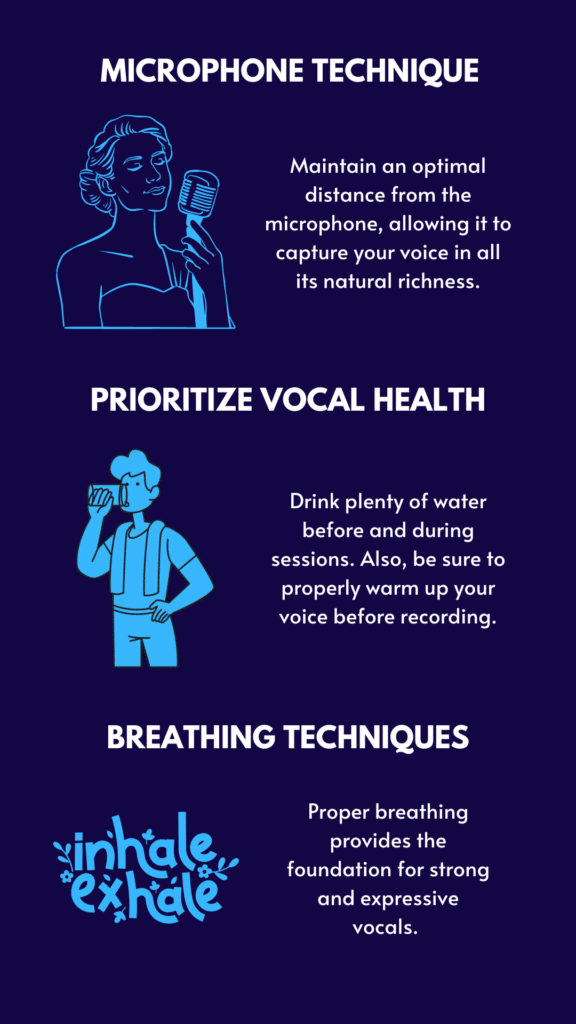
By paying attention to microphone technique, vocal health, and breathing, you empower yourself to deliver performances that resonate deeply with your audience. So take the time to refine your vocal skills, explore different vocal techniques, and embrace the full potential of your voice. With dedication and practice, you’ll create recordings that leave a lasting impression and truly showcase your talent.
3. Overlooking Room Acoustics
When it comes to recording your voice, the importance of room acoustics cannot be overstated. The characteristics of your recording environment have a significant impact on the overall sound quality of your recordings. Neglecting to address room acoustics can result in subpar audio that lacks clarity and professional polish.
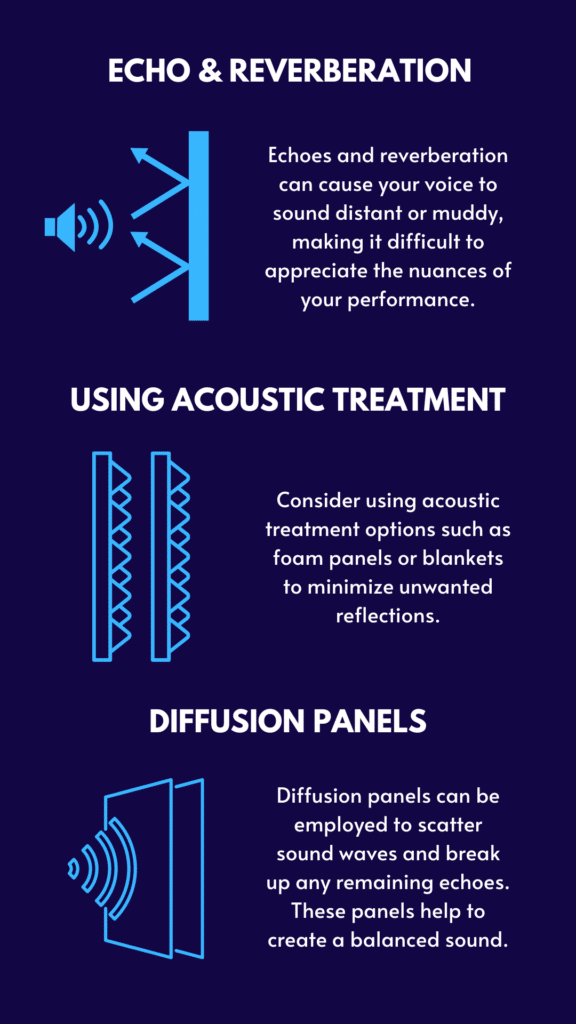
Avoiding Excessive Echo and Reverberation
One common mistake is recording in rooms with excessive echo or reverberation. These unwanted sound reflections can cause your voice to sound distant or muddy, making it difficult for listeners to fully appreciate the nuances and details of your performance. To avoid this, it’s essential to choose a suitable recording space and make necessary adjustments to improve its acoustics.
Using Acoustic Treatment for Reflection Control
Consider using acoustic treatment options such as foam panels or blankets to minimize unwanted reflections. These materials can be strategically placed on walls, ceilings, and other surfaces to absorb sound waves and reduce echo. Controlling reflections creates a focused acoustic environment that enhances voice clarity in recordings.
Enhancing Acoustics with Diffusion
In addition to absorption, diffusion panels can also be employed to scatter sound waves and break up any remaining echoes, further improving the acoustics of your recording space. These panels create balanced sound and prevent excessive frequency buildup for a pleasant listening experience.
Optimizing Your Recording Environment
It’s important to note that while professional soundproofing and acoustic treatments can greatly improve the acoustics of a recording space, you don’t necessarily need a dedicated studio to achieve satisfactory results. Thick curtains or rugs minimize reflections and improve sound quality in home recordings.
By paying attention to room acoustics and making necessary adjustments, you create a more favorable sonic environment that allows your voice to shine. The improved acoustics will enhance the clarity, intelligibility, and overall quality of your recordings, ensuring that your audience can fully appreciate the beauty and subtleties of your vocal performance. Don’t overlook the significance of room acoustics in your recording process. Take the time to optimize your recording environment, and you’ll be rewarded with recordings that sound professional and captivating.
4. Failing to Control Unwanted Noise
Unwanted noise can be the bane of a pristine voice recording, undermining the quality and professionalism of your audio. To ensure clean and polished recordings, it’s crucial to be vigilant about controlling and minimizing unwanted noise.
Background noises such as lip smacks, breathing sounds, hums, or hisses can find their way into your recordings and distract listeners from the intended focus. These extraneous sounds can diminish the impact of your voice and detract from the overall listening experience. By taking proactive steps to control unwanted noise, you can elevate the quality of your recordings and captivate your audience.
Proper Microphone Technique for Noise Reduction
Maintaining proper microphone technique is key to reducing unwanted noise. Positioning the microphone at the optimal distance from your mouth helps capture the desired vocal tone while minimizing background sounds. Find the sweet spot for microphone placement that captures nuances and reduces unwanted noise.
Harnessing the Power of Pop Filters
Another effective tool for controlling unwanted noise is the use of pop filters. These simple yet powerful devices act as a barrier between your mouth and the microphone, reducing plosive sounds that result from pronouncing words with strong bursts of air. By placing a pop filter between you and the microphone, you can mitigate the impact of plosive sounds like “p” and “t” sounds, resulting in cleaner recordings.
Addressing Lip Smacks for a Polished Recording
Furthermore, addressing lip smacks is essential for maintaining a smooth and professional recording. While lip smacks may be a natural occurrence, they can be distracting when present in your recordings. To minimize their impact, keep your mouth moist by staying hydrated, and consider using lip balm if necessary. Take small measures to reduce lip smacks for a polished listening experience.
The Power of Post-Production Editing
In post-production, audio editing software becomes a valuable ally for further noise control. These tools offer features such as noise reduction, spectral editing, and audio restoration that can help eliminate or reduce unwanted noise in your recordings. Invest time in familiarizing yourself with these editing techniques to refine your recordings and enhance their overall quality.
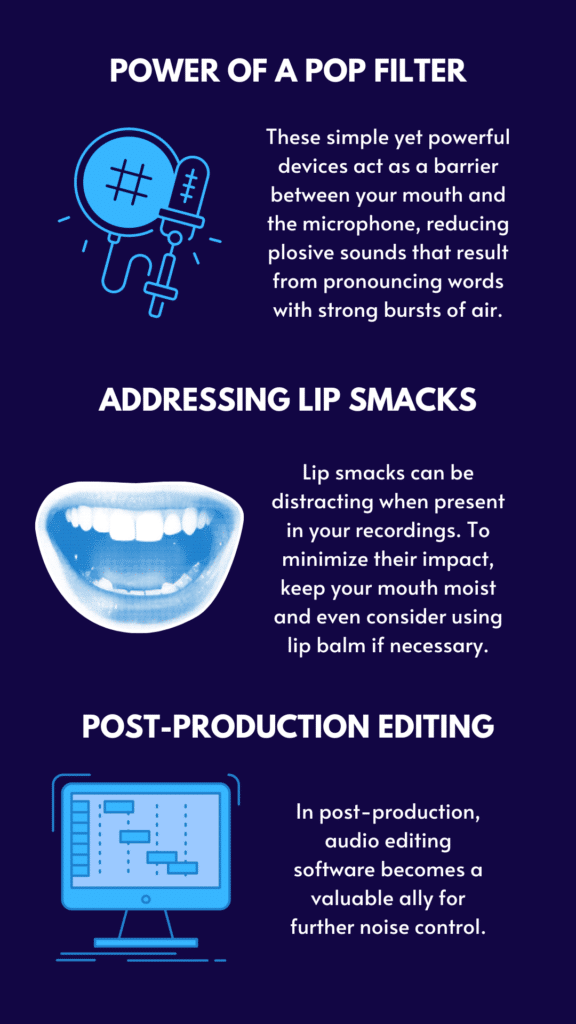
Remember, the goal is to create a seamless and immersive listening experience for your audience, free from distractions and unwanted noise. By paying attention to proper microphone technique, using tools like pop filters, and addressing lip smacks, you can take control of the sound environment and deliver clean and professional voice recordings that captivate and engage your listeners. Don’t let unwanted noise sabotage the impact of your voice. Take proactive steps to control and minimize it, and your recordings will shine with clarity and excellence.
5. Neglecting Post-Production Editing
Even with a well-executed recording, the true potential of your voice tracks can be unlocked through the power of post-production editing. Neglecting this crucial step can leave your recordings sounding unfinished or lacking in polish. To achieve the highest quality and professional results, it’s essential not to overlook the importance of post-production editing.
Post-production editing offers a range of techniques and tools that allow you to refine and enhance your voice recordings. Be sure to dedicate time to post-production for polished and professional audio.
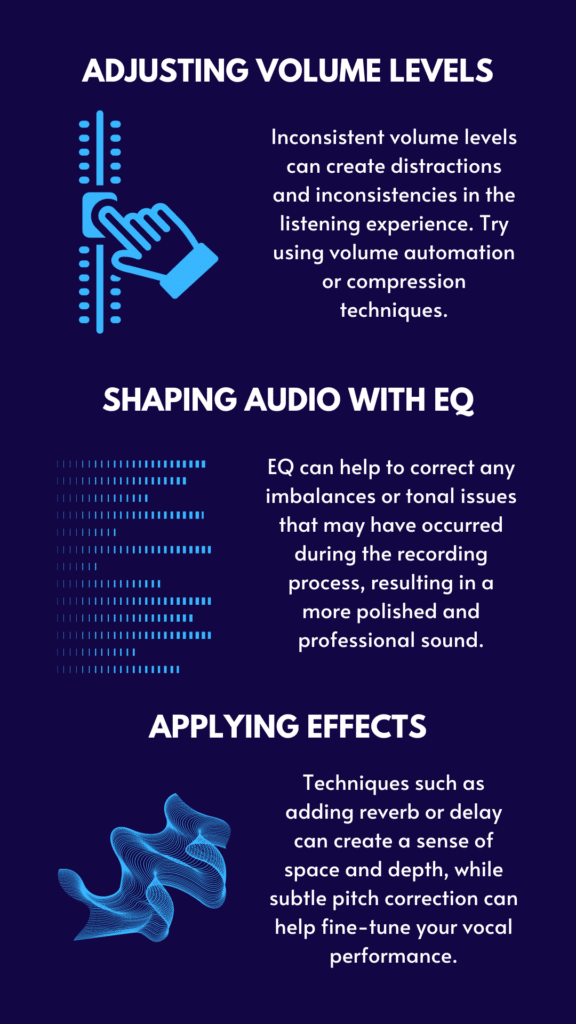
Removing Background Noise
One of the key aspects of post-production editing is removing background noise. Even with the most carefully crafted recording setup, it’s common for unwanted noise to find its way into the recording. Background noise can include ambient sounds, electrical hum, or other environmental factors that detract from the clarity and focus of your voice. By utilizing noise reduction tools or techniques in your audio editing software, you can effectively eliminate or minimize these distracting noises, resulting in a cleaner and more professional sound.
Adjusting Volume Levels
Adjusting volume levels is another essential step in post-production editing. It’s crucial to ensure that your voice tracks are balanced and consistent throughout the recording. Inconsistent volume levels can create distractions and inconsistencies in the listening experience. By using volume automation or compression techniques, you can smooth out any unevenness in the audio and ensure a more uniform and pleasing result.
Shaping the Tonal Balance with Equalization
Equalization, or EQ, is a powerful tool in post-production editing that allows you to shape the tonal balance of your voice recordings. By making subtle adjustments to the frequency spectrum, you can enhance the clarity, warmth, or presence of your voice. EQ can help to correct any imbalances or tonal issues that may have occurred during the recording process, resulting in a more polished and professional sound.
Applying Effects and Enhancements
Additionally, post-production editing offers the opportunity to apply other effects and enhancements to your voice recordings. Techniques such as adding reverb or delay can create a sense of space and depth, while subtle pitch correction can help fine-tune your vocal performance. Experimenting with these effects can add a touch of creativity and artistic flair to your recordings, elevating them to a new level of professionalism.
Remember, post-production editing is not about altering or disguising your voice, but rather enhancing its natural qualities and ensuring a clean and professional result. By embracing the possibilities of post-production editing, you have the opportunity to refine and perfect your voice recordings, delivering a final product that captivates and engages your audience.
So, resist the temptation to skip or rush through the post-production phase. Take the time to listen attentively to your recordings, remove background noise, adjust volume levels, apply equalization, and explore other creative enhancements. Embrace the art of post-production editing, and your voice recordings will shine with polished and professional brilliance that truly showcases your talent and captivates your listeners.
6. Disregarding Technical Considerations
When it comes to recording your voice, technical considerations play a crucial role in ensuring the highest quality and compatibility of your audio files. Disregarding these important technical aspects can lead to compromised fidelity and compatibility issues that hinder the overall success of your recordings. To achieve optimal results, it’s essential to pay attention to the following technical considerations throughout the recording process.
Sample Rate: Accurately Capturing Frequencies
One key technical consideration is the sample rate, which refers to the number of samples per second that are captured during the recording. Choosing the appropriate sample rate is essential to accurately represent the frequencies in your voice. Higher sample rates, such as 44.1 kHz or 48 kHz, are commonly used in professional audio production to capture a wide range of frequencies and ensure accurate reproduction. Lower sample rates can result in a loss of detail and clarity in your recordings. Therefore, it’s important to choose a sample rate that suits your project and recording equipment.
Bit Depth & File Formats: Enhancing Dynamic Range and Audio Quality
Bit depth is another technical consideration that significantly impacts the quality of your voice recordings. The number of bits used to represent the amplitude of each sample is known as bit depth. A higher bit depth, like 24 bits, captures more detail and subtleties in your voice. Lower bit depths, such as 16 bits, can result in a reduced dynamic range and potential loss of audio information. It’s crucial to select the appropriate bit depth for your recordings to maintain the highest quality and fidelity.
File formats are yet another important technical consideration that directly affects compatibility and audio quality. It’s vital to choose file formats that are widely supported and maintain the integrity of your recordings. Commonly used formats for audio recordings include WAV and AIFF, which offer uncompressed and lossless audio quality. These formats are ideal for preserving the full fidelity of your voice recordings. Alternatively, compressed formats like MP3 or AAC sacrifice audio quality for distribution purposes. It’s essential to consider the intended use of your recordings and select the appropriate file format accordingly.
Consistency in Technical Settings for a Seamless Workflow
Consistency in technical settings across all stages of production is paramount. From the recording phase to post-production and final delivery, maintaining consistent technical settings ensures compatibility and a seamless workflow. Document and adhere to the chosen sample rate, bit depth, and file formats consistently. This consistency eliminates potential issues during editing, mixing, and exporting, resulting in a cohesive and professional final product.
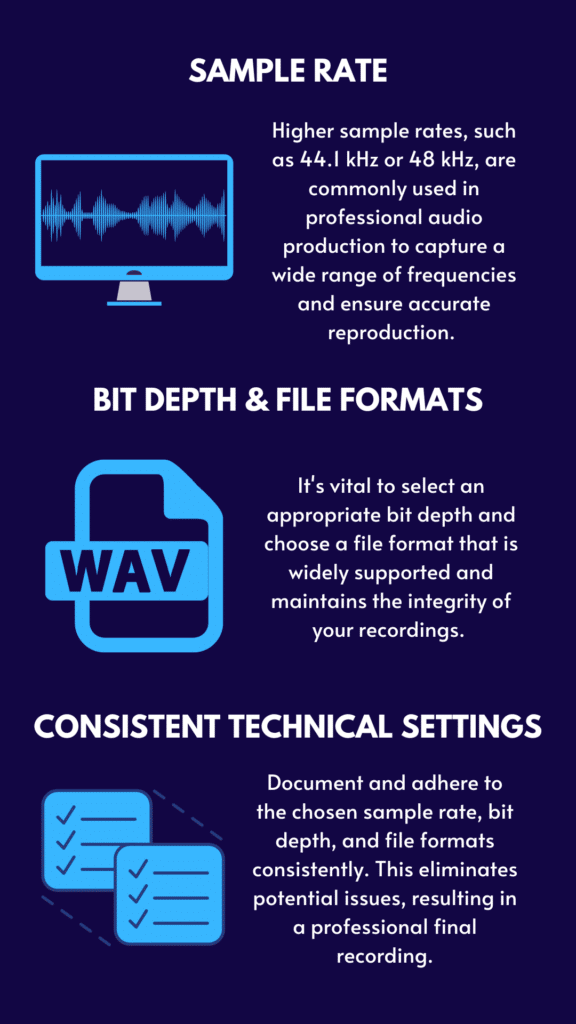
By paying close attention to technical considerations such as sample rate, bit depth, and file formats, you ensure compatibility, maintain the highest quality, and maximize the potential of your voice recordings. Neglecting these technical aspects can lead to compromised audio fidelity, compatibility issues, and a less professional end result. Select appropriate settings, stay consistent, and strive for technical excellence in your recording journey.
Technical considerations are critical for the success and quality of your voice recordings. Embrace the technical side for impeccable recordings that resonate with your audience.
Final Thoughts
By avoiding these common mistakes and following best practices, you can significantly improve the quality of your voice recordings. Remember to invest in quality equipment, optimize your recording environment, and pay attention to vocal techniques and performance. By paying attention to detail and post-production editing, you can create clean and professional vocal tracks. Happy recording!
Your Guide to Essential Recording Studio EquipmentSetting up a recording studio can be an exciting journey, whether you’re a beginner looking to explore your passion for audio production or a seasoned professional seeking to elevate your craft. This guide covers everything you need to know about essential recording studio equipment, offering expert advice and insights to help you make informed decisions for your unique needs.
1. Choosing the Right Space for Your Studio
Before diving into equipment, choosing an appropriate space for your recording studio is crucial. Consider factors such as room size, shape, ambient noise, and natural light. Ideally, the space should be large enough to accommodate your equipment, and the room’s shape should minimize sound reflections. Avoid spaces with excessive ambient noise, and ensure enough natural light creates a comfortable working environment. The principles of setting up an effective studio not only cater to audio production but also create a versatile environment suitable for various content creation needs.
2. The Foundation: Computers and DAWs
A powerful computer and Digital Audio Workstation (DAW) software is the heart of any modern recording studio. Choose a computer with enough processing power, RAM, and storage to handle your audio projects. Mac and Windows-based systems are both suitable for audio production, so choose one that best fits your preferences and budget.
Popular DAWs include Pro Tools, Logic Pro, Ableton Live, and FL Studio. Each has its strengths and weaknesses, so research and test different options before deciding on the one that suits your workflow and production style.
3. Capturing Your Sound: Microphones and Accessories
Microphones are essential for capturing vocals, instruments, and other sound sources. There are two primary types of microphones: dynamic and condenser. Dynamic microphones are more rugged and suitable for recording loud sources, while condenser microphones are more sensitive and ideal for capturing delicate nuances in vocals and acoustic instruments.
Invest in a variety of microphones to handle different recording situations. Essential accessories include microphone stands, pop filters, and shock mounts to ensure proper positioning and minimize unwanted noise.
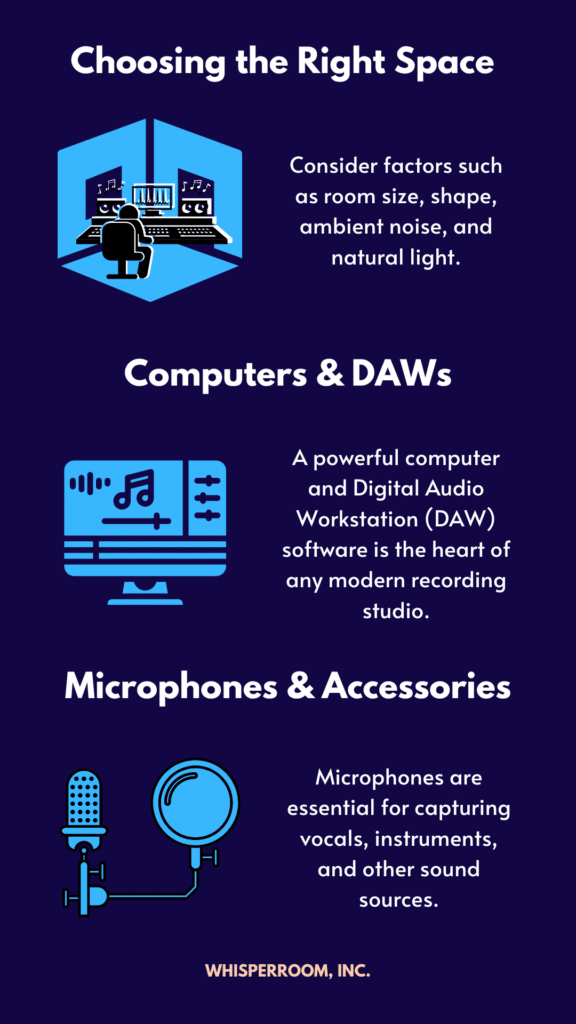
4. Audio Interfaces: Connecting the Pieces
An audio interface is a bridge between your microphones, instruments, and computer. It converts analog signals to digital, allowing you to record and process audio within your DAW. When choosing an audio interface, consider factors such as the number of inputs and outputs, preamp quality, and compatibility with your computer’s connections.
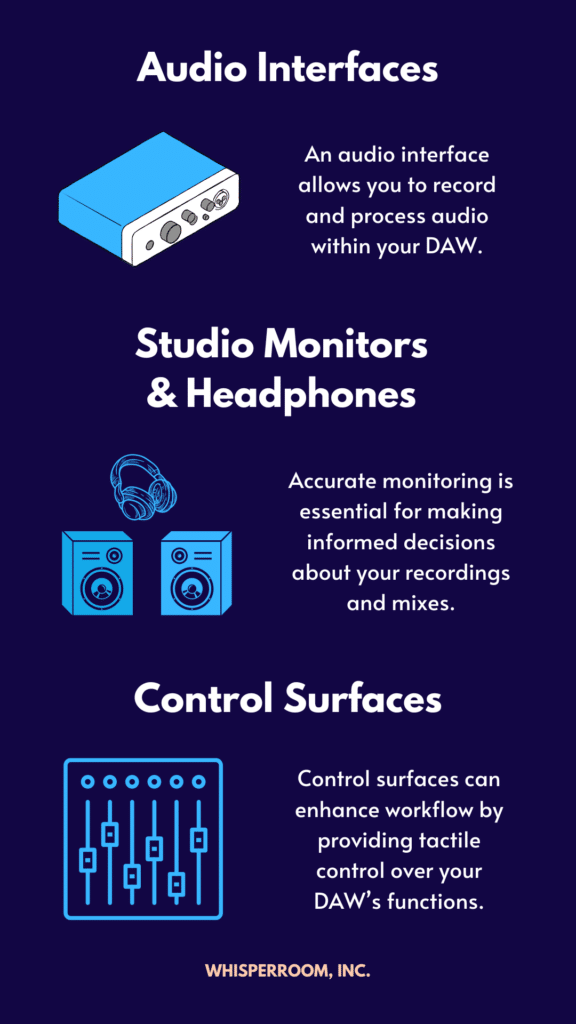
Popular audio interface options include the Focusrite Scarlett, Universal Audio Apollo, and Audient iD. Make sure to choose an interface that meets your needs and fits within your budget.
5. Monitoring Your Sound: Studio Monitors and Headphones
Accurate monitoring is essential for making informed decisions about your recordings and mixes. Invest in a pair of high-quality monitors to clearly represent your audio. Look for monitors with a flat frequency response, ensuring all frequencies are represented accurately.
Additionally, invest in a good pair of studio headphones for critical listening and tracking. Closed-back headphones are recommended for tracking, as they provide better isolation, while open-back headphones are suitable for mixing and offer a more natural soundstage.
6. Control Surfaces: Mastering Your Workflow
Control surfaces can enhance workflow by providing tactile control over your DAW’s functions. These devices often feature faders, knobs, and buttons that allow you to adjust levels, pan, and other parameters without relying solely on your mouse and keyboard.
While not strictly necessary, control surfaces can significantly improve your efficiency and make your recording process more enjoyable. Popular options include the PreSonus FaderPort series, the Avid Artist series, and the Behringer X-Touch series.
7. Outboard Gear: Enhancing Your Sound
Outboard gear, such as preamps, compressors, and equalizers, can further shape and enhance your audio. While many of these functions can be performed within your DAW using plugins, there’s often a unique character and warmth imparted by hardware that’s difficult to replicate with software alone.
When building your collection of outboard gear, start with essentials like a high-quality preamp for clean and transparent amplification of your microphones and a versatile compressor to control dynamics and add character to your recordings. As you expand your studio, add additional processors such as equalizers, reverb units, and other effects to broaden your sonic palette.
Some popular outboard gear options include the Universal Audio LA-610 MkII, the DBX 266xs, and the Warm Audio WA-2A.
8. Acoustic Treatment: Perfecting Your Listening Environment
To ensure accurate monitoring and achieve professional-sounding recordings, it’s crucial to acoustically treat your studio space. Acoustic treatment helps control reflections, standing waves, and resonances that can negatively impact your audio.
Start by treating early reflection points with absorption panels. These are typically placed on walls and ceilings where sound bounces directly between your monitors and your listening position. Bass traps are essential for controlling low-frequency build-up in corners, while diffusers can help to scatter and disperse sound energy, creating a more balanced listening environment.
DIY solutions can be effective and budget-friendly, or you can invest in professionally designed acoustic treatment products from companies like GIK Acoustics, Auralex, Primacoustic, and Audimute.
9. Cables, Stands, and Other Accessories
Don’t overlook the importance of quality cables, stands, and other accessories in your recording studio. Investing in high-quality cables can minimize signal loss and interference, ensuring the best possible audio quality.
Ensure you have a variety of cable types and lengths to accommodate different connections, such as XLR, TRS, and instrument cables. Cable management tools, like cable ties and organizers, can help keep your studio tidy and clutter-free.
Additionally, invest in sturdy and adjustable stands for your microphones, monitors, and instruments. A comfortable studio chair and ergonomic workstation setup will also create a more enjoyable and productive recording experience.
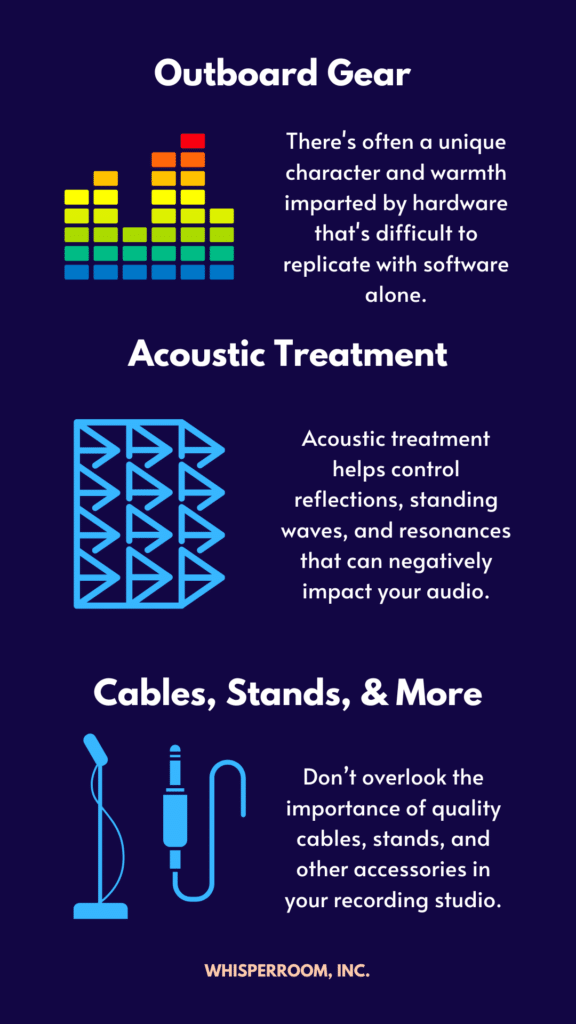
Putting It All Together
Equipping your recording studio with essential gear is important to realizing your creative vision and producing high-quality audio. By carefully selecting the right equipment and optimizing your workspace, you’ll be well on your way to achieving professional results and making your mark in the world of audio production. Remember that your studio can always grow and evolve with you, so stay curious, keep learning, and continue to invest in your craft.
Why Sound Isolation Matters: Understanding the Benefits for MusiciansWe’ll talk about the value of sound isolation in your private studio and its several advantages for musicians in this piece. You will discover how soundproofing may boost productivity and creativity, increase adaptability, improve sound isolation, and even boost the value of your home.
To design a comfortable living area, sound insulation is crucial. You are protected from outside noise intrusion by sound insulation. The music next door, passing automobiles outside, and other noises will undoubtedly disturb you if you reside in an area with insufficient sound insulation efficiency. You are probably more irritated by the noise coming from across the room (music and chatting) than by sounds coming from outside since buildings are getting more airtight. High sound-insulating walls are necessary for tranquil living and restfulness.
Why Sound Isolation Matters
Whether you practice on your own time or your youngster is learning new equipment, you need a media room. And regardless of whether this place is private or public, it needs to have optimum isolation.
Practice is essential to the growth of musical skills and building a successful music career. Every musician’s goal is achieved when they have the flexibility to practice at any time of the day or night and have access to a dedicated area with excellent sound.
It’s very feasible. You may have a room that creates excellent sound without worrying about disturbing others. All you need is isolation for the music area.
Universities, colleges, and private institutions all rely on isolation areas to better provide for their students.
What is a house without adequate comfort, too? Your well-being may be severely impacted if outside noise often enters your house. The absence of audio privacy, sufficient sleep, a quiet inside, and several other negative impacts are all possible for households. Additionally, interaction, privacy, and wellness may all suffer from loud sounds. Nowadays, soundproofing houses is crucial because of this.
Consequences of Extended Noise Exposure That Are Negative
Health on both the physical and psychological levels might deteriorate due to ongoing exposure to outside noise. According to research, chronic exposure to loud sounds can have adverse consequences, including high blood pressure, tinnitus, hypertension, hearing loss, heart conditions, sleep disruptions, and other abnormalities.
Chronic sound, particularly in youngsters, can stunt brain growth and hinder learning and reading skills. In reality, loud settings can affect children’s speech fluency and skills in communication. Chronic noise exposure can also have a negative impact on people, increasing stress, generating aggravation, impairing cognitive abilities, lowering productivity, and decreasing job efficiency.
Benefits of Sound Isolation for Musicians
It might be challenging to produce music or broadcast from home with the same loudness and acoustic performance as you could in a dedicated music studio. Yet investing in a sound isolation area is a wonderful approach to enhance your sound production and let you operate without worrying about disturbing your neighbors’ quiet for your music studio.
Increased Innovation and Efficiency
Isolating your personal recording studio may increase the sound quality, your imagination, and efficiency. Distracting and unproductive interruptions might happen when attempting to record or make music. You may immerse yourself in your work and enter a state of creative “flow” when you establish a serene and calm recording environment.
Every musician would be overjoyed if they could get the same result each time they worked in the studio. In addition, fewer distractions may make it simpler for you to focus and generate fresh suggestions or answers.
Moreover, sound isolation can aid in the elimination of outside noise disturbances like traffic, howling pets, or noisy neighbors. This may result in more peaceful and conducive recording environments.
Greater Adaptability
Your recording plan may become more flexible and free if you isolate your music studio. You may record day or night without disturbing anyone around if you have enough isolation. This is vital if you stay strange hours or produce your creative work at night.
Isolation also makes it possible to record live music without disturbing the serenity and quiet. Being able to register without restrictions can expand the artistic possibilities of your work, whether you’re a trumpet or drum player. You can concentrate on getting the ideal take and unleash your creativity by setting up a recording isolated from external noise and interruptions.
Increasing House Value
In addition to being a wise investment for your job or pastime, isolating your recording studio may raise the value of your house. Using permanent sound isolation techniques, you may make a room more adaptable, useful, and desirable to potential home buyers.
By adding a new useable area that can draw in more purchasers, insulation might raise the peace of your house. The finest possibilities for making an isolated sound place are renovated spare rooms, garages, and basements. If the isolation is done properly, future occupants may use these areas as an audio system, entertainment area, or gym.
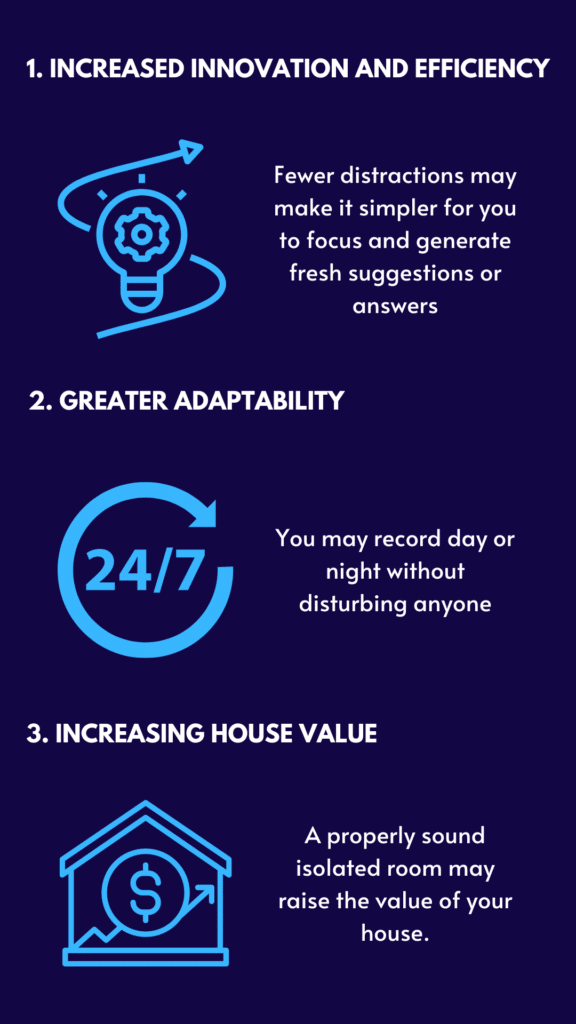
Final Reflections
The advantages of isolating a home music studio for musicians are considerable and cannot be emphasized. Sound isolation enhances innovation and productivity, provides more flexibility, and increases home value, all of which contribute to a more joyful and productive music environment. In addition, soundproofing your studio may be transformative for your performances, regardless of whether you’re a successful musician or just a music hobbyist.
_______________________________________________________
Several people shop mwave coupon code to buy musical instruments to polish their skills at home or help their child’s desires. Whatever your motivation, their amazing equipment options will make your music room nicer.
Overcoming Social Anxieties with MusicSocial anxiety disorder can be debilitating. Everyday nerves can quickly turn into a genuine fear of socialization and natural thoughts about your appearance can spiral into an overwhelming concern about embarrassing yourself.
Unfortunately, global rates of generalized anxiety have skyrocketed in the past few years. A recent World Health Organization (WHO) report found that COVID-19 triggered a 25% increase in anxiety and depression as many struggled with isolation and financial fears.
There’s no “right” way to overcome social anxiety. However, you may find solace in music. Music and music therapy can be a catalyst for self-exploration, collaboration, and improved self-esteem.
Music Therapy
Music therapy is a great way to overcome social anxiety. Music therapy is a well-established sub-field of psychological therapy and doesn’t require any previous experience. You don’t have to have extreme social anxiety to benefit from music therapy, either, as trained psychologists will adapt to your skills and interests.
You can benefit from music therapy even if you don’t play an instrument. Some music therapists offer services that revolve around dance or discussions about the music you listen to, while others help you vocalize your thoughts through song.
Music therapy can help you build community, too. Some therapists offer group sessions where you can bond with folks who share a common love for similar bands or genres. Sharing your thoughts in a safe space may even give you the confidence you need to step outside your safe zone and start a band yourself.

Writing for a Band
Playing music in a band can be a deeply rewarding and affirming experience. You’re sharing your inner self with other people and are using the medium of music to form social bonds.
However, before you start riffing with strangers, you should set clear parameters to ensure that everyone’s expectations are aligned. You don’t want to start a casual band only to discover that some members are intent on becoming full-time professional musicians. Make it clear that you’re playing for personal enrichment and encourage members to support each other.
The idea of playing in a band can be anxiety-inducing. However, sharing a hobby with trusted friends can be a great way to overcome social anxiety. You’ll quickly bond over your shared interest in playing music and may find that playing together gives you the strength to engage in other social events.
There’s no need to share your band’s creative endeavors publicly. However, sharing your music may represent an important step forward in overcoming social anxiety.

Sharing Your Creations
You do not have to share your music publicly. However, if you’re a goal-oriented person, then you may find performing rewarding.
Fortunately, you don’t have to sign up for “Battle of the Bands” or open mics in your town to share your music. Nowadays, it’s possible to live stream whenever you want to share your tunes or hear from an engaged audience.
Live streaming is particularly rewarding if you are a beginner. Going live on sites like Twitch is completely free and may even land you some extra income in the form of tips and donations. Just be aware that anyone can comment on your stream, so you’ll need to be resilient enough to handle some negative or unwanted comments.
Resilience and Self-Efficacy
Social anxiety is commonly associated with low self-esteem and poor self-efficacy. Lowered self-esteem can feed your social anxiety and cause a negative feedback loop.
You can use music to break the cycle of poor self-esteem and low self-efficacy. As a budding musician, you’ll gain important skills and see the value in self-development.
If it’s your first time playing music, consider picking up an instrument that is popular but easy to learn. Great instruments for beginners include:
- Tin whistle
- Ukulele
- Steel drums
- Keyboard
Utilize free tutorials and join supportive communities on sites like Reddit. You’ll find plenty of expert guidance for free online and can slowly develop your skills over time.
Once you find an instrument you enjoy playing, consider joining a musical group in your community. You’ll make quick friends with folks who play in bluegrass groups or informal big bands. Most groups are more than happy to accommodate beginners, too.
Consider recording yourself at least once a month to track your progress. It’s easy to underestimate your improvement when you are suffering from anxiety. Recording yourself will give you a physical record of your progress and can help you build self-belief.
Conclusion
Social anxiety has been on the rise in recent years. A trained music therapist can help you navigate your thoughts and behaviors or encourage you to venture outside of your comfort zone.
Playing music can be a great way to build your confidence and overcome social anxiety, too. Start small with beginner-friendly instruments like tin whistles and ukuleles. When you’re ready, consider sharing your music with others. Either join a band with trusted friends or consider live streaming to a digital audience.
Top Features to Look for in an Audiometric Booth: Why WhisperRoom Stands OutAs a leading manufacturer of audiometric booths, WhisperRoom is dedicated to providing high-quality, reliable solutions for accurate hearing testing. Choosing the right audiometric booth is crucial to ensure accurate and reliable results, and it can be a daunting task. With so many options available on the market, it’s important to know what features to look for. In this article, we’ll discuss the top features to consider when choosing an audiometric booth and why WhisperRoom stands out as a top choice for hearing testing professionals.
1. Sound Isolation
When it comes to audiometric testing, sound isolation is critical. The last thing anyone wants is for outside noise to interfere with the results of a hearing test. WhisperRoom understands this need and we have designed our booths with isolation as a top priority.
Compared to other hearing booth manufacturers, WhisperRoom achieves superior sound isolation through specific features and easy-to-assemble construction techniques. Single-wall isolation, double-walled panels with an air gap, sealed door systems, and multi-layered windows all contribute to a highly effective sound isolation system. These features help to ensure that the booth remains an ideal acoustic environment for accurate and reliable hearing testing.
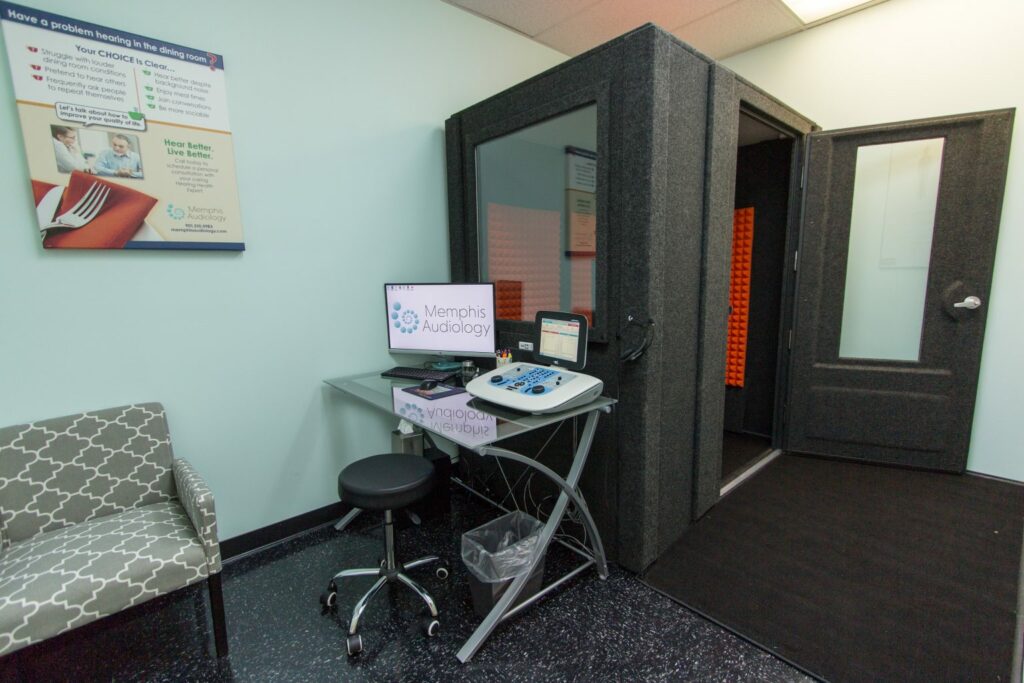
2. Size and Customization
Choosing the right size and customization options for an audiometric booth is essential to creating an optimal testing environment.
WhisperRoom offers a wide range of sizes and customization options to fit specific testing needs, including the addition of windows, an ADA package, interior lighting, and much more.
Whether you need a compact single-person booth or a larger booth to accommodate multiple testers or equipment, we have a reliable and comfortable testing environment.
Audiology Booth Packages
Searching for a suitable audiometric booth can be a tedious, expensive, and exasperating process. We understand this predicament and have developed two audiology suites as pre-packaged solutions. These control rooms offer you our most popular booth configurations for hearing tests.
Our team designed audiology packages to provide a comprehensive solution for your hearing testing needs. We’ve included our most popular booth configurations and a set of features that are tailored for the audiology industry. You can apply the package features to any of our 26 booth sizes, which gives you the flexibility to choose the size that best suits your facility’s needs.
With the added convenience of a 5% discount, you can rest assured that you’re getting the best value for your investment. Plus, you can save time and effort in selecting the right booth configuration, making the process more efficient and stress-free.
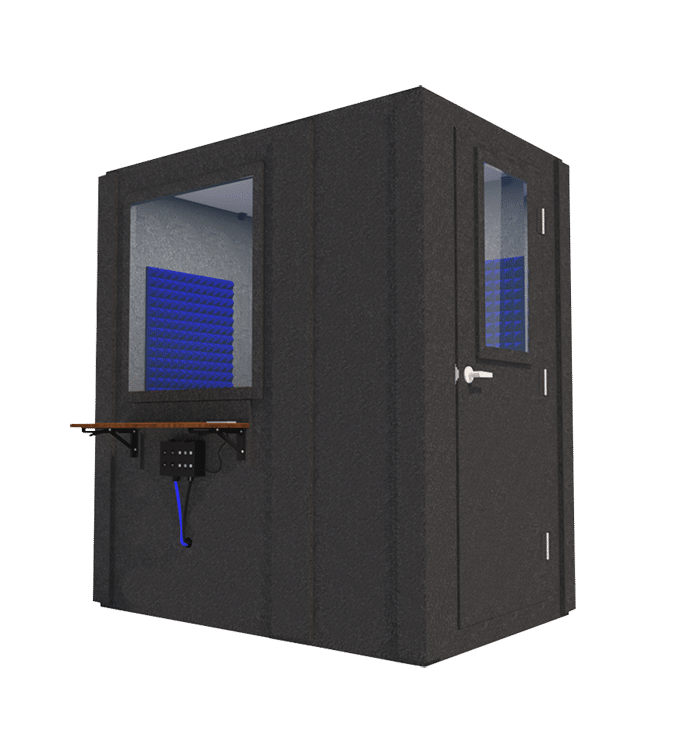
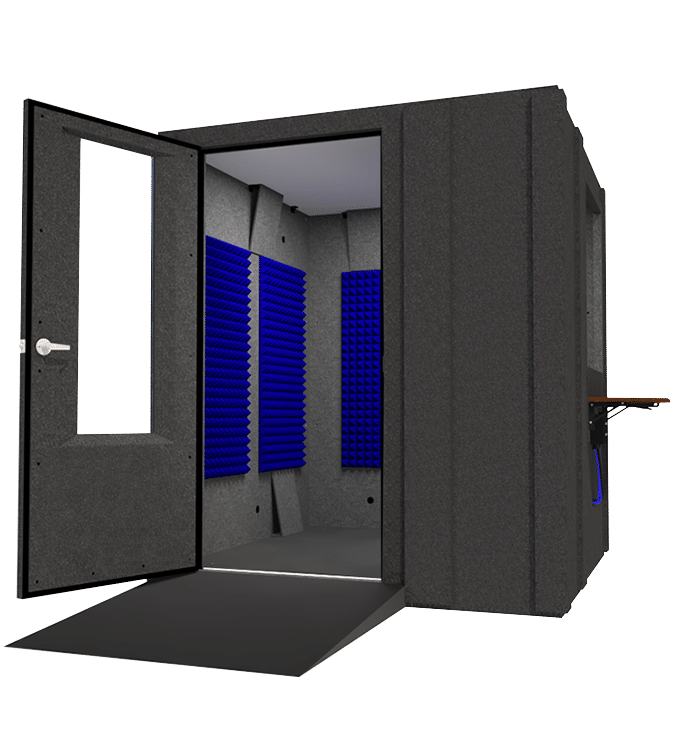
3. Ventilation
Proper ventilation is another key consideration when shopping for a new audiometric booth. Without adequate airflow, occupants can quickly become uncomfortable.
WhisperRoom has thoughtfully incorporated ventilation silencing features into our audiology booth designs to ensure clients can maintain a comfortable testing environment while still achieving optimal testing parameters.
We offer two unique features that significantly reduce noise ventilation noise during audiology testing, the Ventilation Silencing System (VSS) and the Exterior Fan Silencer (EFS).
Inside the booth, the Ventilation Silencing System (VSS) isolates the sound of the fan to ensure that hearing tests are not affected by any unwanted noise. Meanwhile, the Exterior Fan Silencer (EFS) significantly reduces noise from the Remote Fan Unit that is outside of the booth. We position the EFS around each fan to eliminate any residual noise, creating an incredibly quiet and efficient testing environment. With these features, your audiology testing is not only accurate but also as comfortable and quiet as possible.
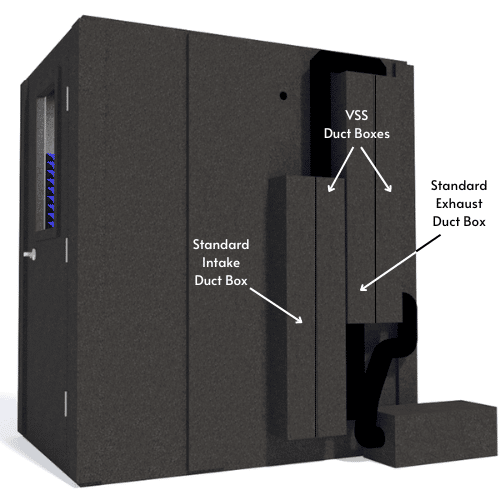
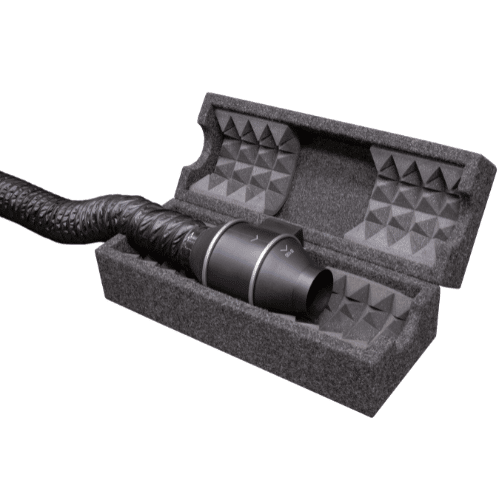
4. Certification and Compliance
Choosing an audiometric booth that meets or exceeds industry standards and certifications is key. In this regard, WhisperRoom stands out as we design and construct our booths to meet various certification requirements, such as OSHA, ADA Accommodation, and ANSI Standards.
We test our products sound isolation, ventilation, and other factors to ensure that they comply with all necessary regulations. Opting for a WhisperRoom booth means you can trust that you’re getting a product that’s compliant, can be certified, and meets the highest quality standards.
Learn more about certification, compliance, and testing methods by contacting your Product Representative.
5. Durability and Expansion
We construct our booths to withstand the wear and tear of daily use, providing you with a space that lasts for years. WhisperRoom makes each booth from high-quality materials that are both durable and easy to maintain. We use ¾” MDF (Medium Density Fiberboard) for all interior and exterior components of our audiometric booths, including the doors. The components are precision cut using a CNC router to ensure accurate fitting and are completely covered in a durable, charcoal gray cloth material that is also visually appealing.
Also, if your audiology practice moves locations or you find that your office becomes a high-traffic area, you have the option to upgrade your WhisperRoom from Standard (single-wall) isolation to Enhanced (double-wall) isolation. Upgrading to an Enhanced system is easy and convenient. You can install the appropriate Isolation Enhancement Package (IEP) at any time to increase sound isolation and provide additional protection for sensitive hearing tests.
This ensures that your WhisperRoom will continue to meet your evolving needs and provide a reliable and durable testing environment for your patients.
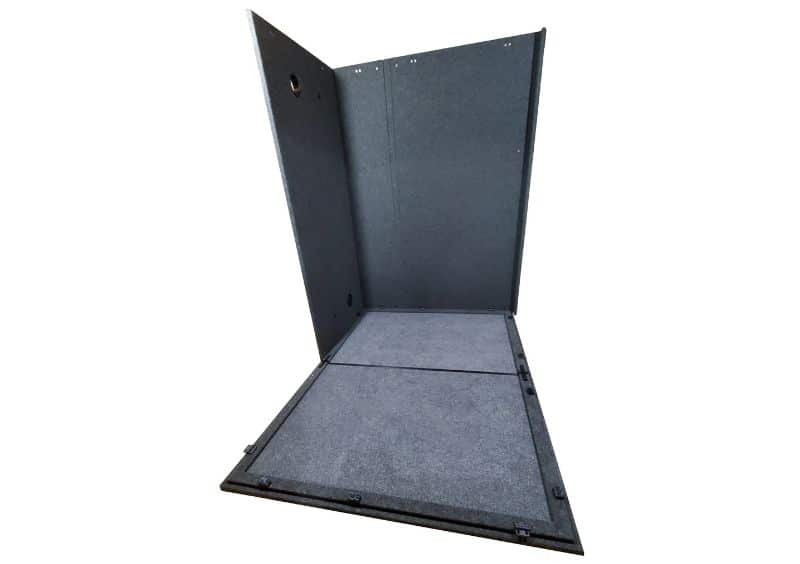
6. Fast Turn Around Time
When it comes to purchasing an audiometric booth, a quick turnaround time can be critical. That’s why WhisperRoom stands out as a top choice for audiologists and hearing specialists. We keep all components of our booths in-stock and on-hand, which allows us to ship most orders within 48 hours.

Additionally, we take pride in making all of our products in the USA, ensuring that you receive a high-quality, domestically produced product. With WhisperRoom, you can have peace of mind knowing that your order will be processed quickly and efficiently, so you can get back to your work of providing accurate and reliable hearing tests.
See What Our Clients Are Saying
Hearing from other audiology professionals who have already invested in a WhisperRoom booth can provide valuable insight. WhisperRoom has an impressive collection of testimonials from satisfied customers within the audiology community.
These testimonials highlight the quality of the sound isolation, ease of installation, and exceptional customer service that WhisperRoom provides. From small audiology practices to large medical facilities, WhisperRoom has a proven track record of meeting the unique needs of each client.
Hearing from these professionals can help guide your decision-making process and provide confidence in your investment in a new WhisperRoom audiology booth.
_______________________
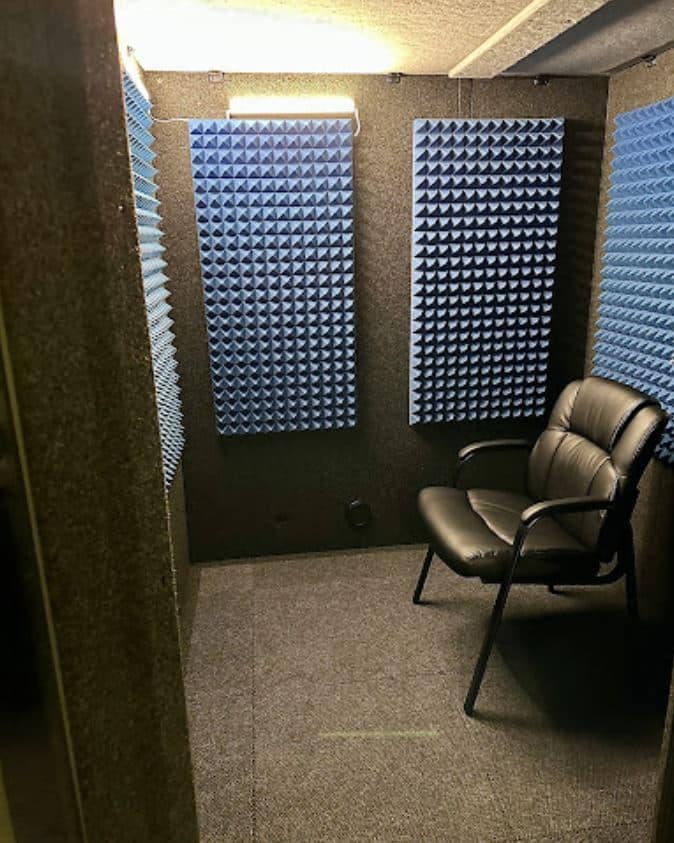
“Great experience with WhisperRoom. Jill and Sarah were fantastic to work with. I was hesitant about assembly on our own, but it was completed with no issues. Sarah was very helpful and was able to personalize the delivery to our unique situation. I’ve been told by multiple people it’s the nicest hearing booth they have ever been in! Would highly recommend!”
Jaclyn Charie, Au. D. – Owner & Audiologist | Hearing AuD
_______________________
“Awesome product. Our patients love the roominess and comfort they feel when using our WhisperRoom booths.”
David Brooks, RHIP | Wavefront Centre for Communication Accessibility
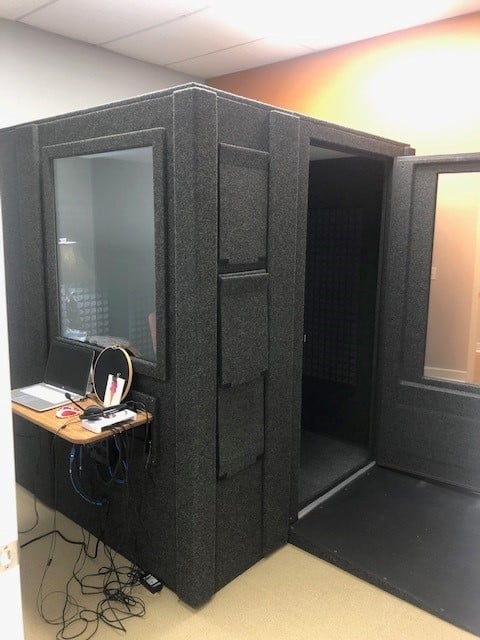
_______________________
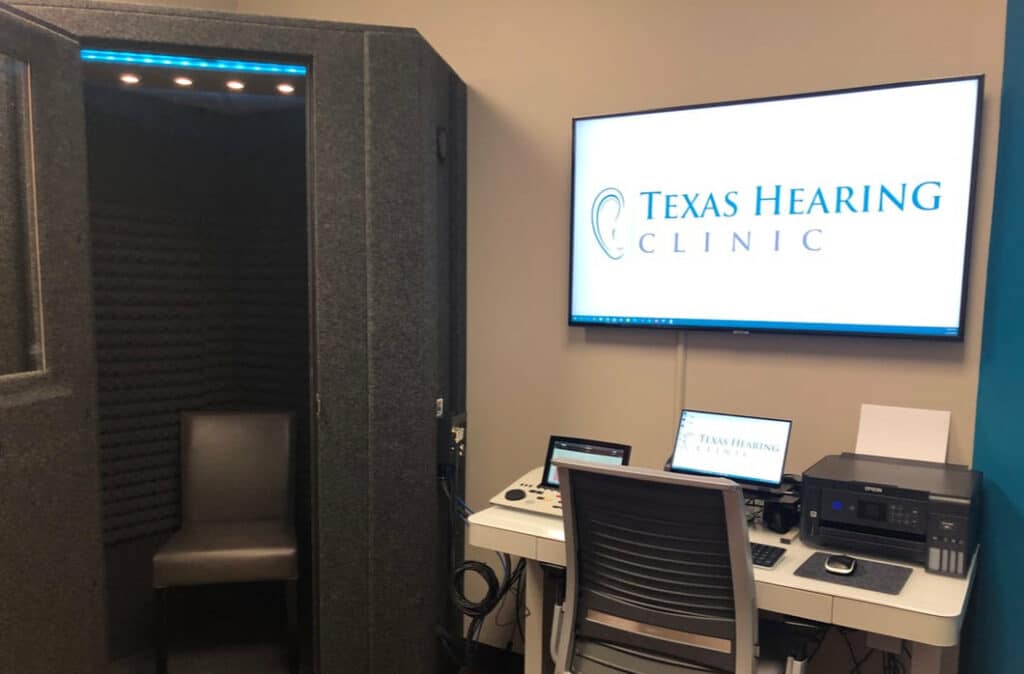
“WhisperRoom makes the very best in sound isolation enclosures. We’ve purchased 3 in the past couple of years and will be buying more. Love this product!”
Steve Burrington, Owner, Operations Director | Texas Hearing Clinic
_______________________
“We operate a physical therapy clinic and recently added a speech-language pathologist. In treating patients with vocal issues, some therapy includes loud speaking, approaching 85 decibels. We needed a room that would serve this function without disrupting our normal PT patients. After a great deal of research, I found the Whisper Room! Our staff loves it! It looks great in our clinic, and the sound reduction is better than I anticipated. The setup was straightforward and the delivery company placed the pallet exactly next to the spot we desired to set the room up. Jill Holdway was wonderful to deal with and helped me set up the options that we needed, such as the ADA ramp and floor. I can truly say that if I ever have the need for another sound reduction room, I would order the Whisper Room again!”
Jeff Barrows, Owner | Total Rehabilitation, Inc.
_______________________
“I bought a WhisperRoom in November. I just opened my practice and wanted a good reliable room for audiologic testing. It came on a pallet and with a friend’s help, we moved it from the pallet to my clinic space. We then built it in about 4.5 hours. I love using this WhisperRoom, it suits my needs perfectly.”
Liz White, Au. D. – Owner & Audiologist | Harbor City Hearing Solutions
_______________________
Final Thoughts
Choose WhisperRoom for your audiometric booth needs and experience the benefits of a premium product backed by excellent customer support.
